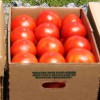 A BMP study was conducted at the research farm of the UF/IFAS Southwest Florida Research and Education Center in Immokalee, FL. The study evaluated two production systems made up of two levels of water and fertilizer inputs for tomato and watermelon production with seepage irrigation. The average water and P fertilizer rates used by growers in south Florida were contrasted with the recommended BMP rates. Applying BMP-recommended water and phosphorus (P) inputs for seepage-irrigated tomato and watermelon in Florida can reduce water use and P leaching to groundwater without adversely impacting fruit yield. However, given the adverse impacts on watermelon yield due to lower than sufficient levels of K, further research is needed to evaluate the fertilizer recommendations for watermelon, especially K2O rates, to ensure economic viability of farms. Our results showed that adoption of BMP-recommended P rates as a BMP did not reduce crop yield and improved water quality. This 4-page fact sheet was written by Sanjay Shukla, Gregory S. Hendricks, Thomas A. Obreza, and Willie G. Harris, and published by the UF Department of Agricultural and Biological Engineering, June 2014.
A BMP study was conducted at the research farm of the UF/IFAS Southwest Florida Research and Education Center in Immokalee, FL. The study evaluated two production systems made up of two levels of water and fertilizer inputs for tomato and watermelon production with seepage irrigation. The average water and P fertilizer rates used by growers in south Florida were contrasted with the recommended BMP rates. Applying BMP-recommended water and phosphorus (P) inputs for seepage-irrigated tomato and watermelon in Florida can reduce water use and P leaching to groundwater without adversely impacting fruit yield. However, given the adverse impacts on watermelon yield due to lower than sufficient levels of K, further research is needed to evaluate the fertilizer recommendations for watermelon, especially K2O rates, to ensure economic viability of farms. Our results showed that adoption of BMP-recommended P rates as a BMP did not reduce crop yield and improved water quality. This 4-page fact sheet was written by Sanjay Shukla, Gregory S. Hendricks, Thomas A. Obreza, and Willie G. Harris, and published by the UF Department of Agricultural and Biological Engineering, June 2014.
http://edis.ifas.ufl.edu/ae504
Tag: Fertilization and Nutrition of Tomato
Water and Nitrogen BMPs for Tomato and Watermelon: Water Quality and Economics
 Results of a two-year, four-crop-cycles experiment indicated that the recommended Best Management Practice (BMP) water and fertilizer nitrogen (N) rates for seepage-irrigated tomato in south Florida can reduce water use and N leaching to groundwater without adversely impacting yield. The same is true for watermelon for average rainfall conditions. This 5-page fact sheet was written by Sanjay Shukla, Gregory S. Hendricks, Fritz M. Roka, and Thomas A. Obreza, and published by the UF Department of Agricultural and Biological Engineering, May 2014.
Results of a two-year, four-crop-cycles experiment indicated that the recommended Best Management Practice (BMP) water and fertilizer nitrogen (N) rates for seepage-irrigated tomato in south Florida can reduce water use and N leaching to groundwater without adversely impacting yield. The same is true for watermelon for average rainfall conditions. This 5-page fact sheet was written by Sanjay Shukla, Gregory S. Hendricks, Fritz M. Roka, and Thomas A. Obreza, and published by the UF Department of Agricultural and Biological Engineering, May 2014.
http://edis.ifas.ufl.edu/ae503
A Summary of N, P, and K Research with Tomato in Florida (SL355/CV236)
 More than 60 years worth of tomato fertilization research has been conducted in Florida. During this time, many changes have occurred in tomato production practices, including changes in cultivars and the introduction of new cultural systems, such as polyethylene mulch and drip irrigation. The research reported here covers tomato production with polyethylene mulch. Tomato crop and fertilizer management recommendations, such as plant and row spacing, have changed over time following new developments in research. This 38-page fact sheet summarizes tomato fertilization research leading to current University of Florida recommendations and summarizes needs for additional research. Written by George Hochmuth and Ed Hanlon, and published by the UF Department of Soil and Water Science, August 2011. (UF/IFAS Photo by Tyler Jones)
More than 60 years worth of tomato fertilization research has been conducted in Florida. During this time, many changes have occurred in tomato production practices, including changes in cultivars and the introduction of new cultural systems, such as polyethylene mulch and drip irrigation. The research reported here covers tomato production with polyethylene mulch. Tomato crop and fertilizer management recommendations, such as plant and row spacing, have changed over time following new developments in research. This 38-page fact sheet summarizes tomato fertilization research leading to current University of Florida recommendations and summarizes needs for additional research. Written by George Hochmuth and Ed Hanlon, and published by the UF Department of Soil and Water Science, August 2011. (UF/IFAS Photo by Tyler Jones)
http://edis.ifas.ufl.edu/cv236